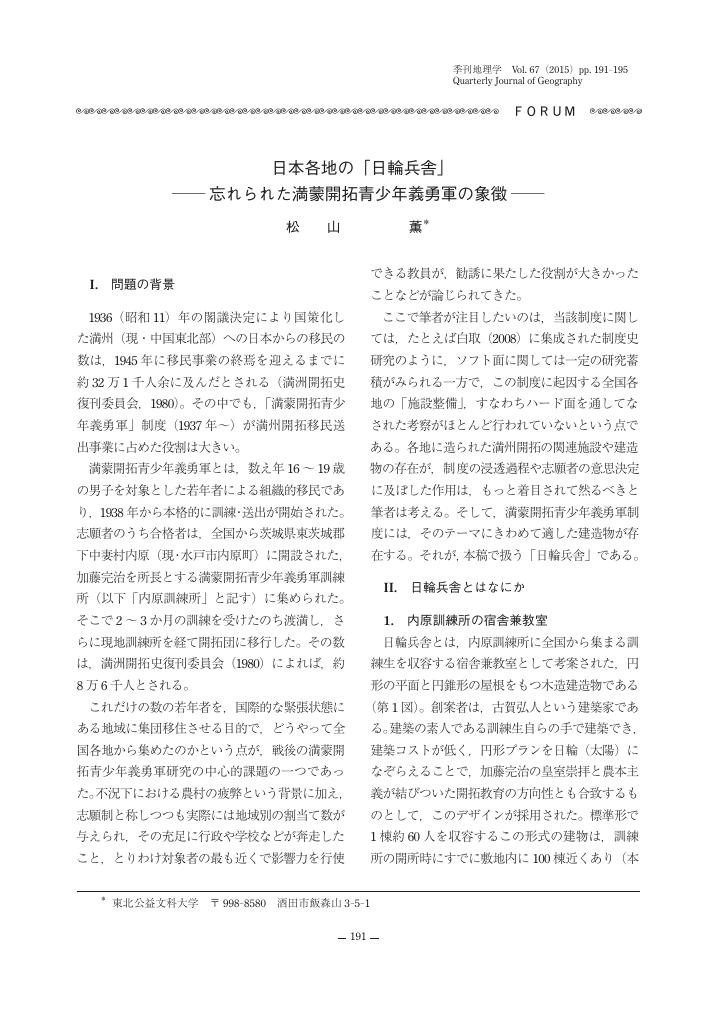7 0 0 0 IR 近代日本における軍事施設の立地に関する考察--都市立地型軍事施設の事例
- 著者
- 松山 薫
- 出版者
- 東北公益文科大学
- 雑誌
- 東北公益文科大学総合研究論集 (ISSN:18806570)
- 巻号頁・発行日
- no.1, pp.157-171, 2001
本稿では,都市立地型軍事施設による空間的な影響を包括的に理解するために,1935年から昭和初期における陸軍師団司令部・旅団司令部所在26都市について,1930年代に発行された都市地図上で軍用地の分布状況を調査した.その結果,師団司令部所在都市に立地する軍用地は,歩兵旅団司令部のみが立地する都市に比べて,件数,面積ともに圧倒的に多いことがわかった.また,都市内における軍用地の分布状況は,城址型と郊外型に分類された.これは,軍用地として取得された時期と大きな関係があると考えられる. This paper examines the location and distribution of military land in the 26 cities which has the Army Headquarters of Division or Brigade in the 1930's. The area of military lands were measured on the city maps published in the 1930's. The total area of military lands in the cities which has the Army Headquarters of Division was much larger than that of in the cities which has that of Brigades. The distribution of those lands in each cities was divided into 2 types; the ones located on the former sites of feudal castle and the others in suburban area. These results could contribute the understanding of spatial influences of military location on urbanization processes in the modernizing period of Japan.
3 0 0 0 OA 日輪兵舎の創案者に関する考察(一)
- 著者
- 松山 薫
- 出版者
- 東北公益文科大学
- 雑誌
- 東北公益文科大学総合研究論集 : Forum 21 (ISSN:18806570)
- 巻号頁・発行日
- no.31, pp.65-73, 2016-12-20
- 著者
- 山口 泰史 松山 薫
- 出版者
- 熊本学園大学付属産業経営研究所
- 雑誌
- 産業経営研究 = Studies of Economics and Business (ISSN:02887371)
- 巻号頁・発行日
- no.42, pp.91-108, 2023-03-31
2 0 0 0 OA 日本各地の「日輪兵舎」─ 忘れられた満蒙開拓青少年義勇軍の象徴 ─
- 著者
- 松山 薫
- 出版者
- 東北地理学会
- 雑誌
- 季刊地理学 (ISSN:09167889)
- 巻号頁・発行日
- vol.67, no.3, pp.191-195, 2015 (Released:2016-01-14)
- 参考文献数
- 16
2 0 0 0 昭和初期の「大呉市」成立過程
- 著者
- 松山 薫
- 出版者
- 公益社団法人 日本地理学会
- 雑誌
- 日本地理学会発表要旨集
- 巻号頁・発行日
- vol.2014, 2014
広島県呉市は、1889(明治22)年の呉鎮守府の開庁を契機に、軍港都市として近代以降急速に発達した都市である。1902年に宮原村、荘山田村、和庄町、二川町が合併して市制を施行し呉市となった。その後、周辺に海軍関連施設用地が拡大するのにともない、さらに隣接町村の合併を視野に入れた「大呉市」構想が模索されたが、それが実現するのは昭和に入ってからであった。すなわち旧呉市に隣接する吉浦町、警固屋町、阿賀町の編入(1928[昭和3]年)、そしてさらに東方の広村、仁方村の編入(1941年)である。こうした市域拡大の背後には海軍の意向が働いていたが、一方で関係する自治体の側も、地域性や歴史的経緯の違いから、合併に対する態度は町村ごとに大きく異なった。本発表では、独自路線を貫こうとしたものの、海軍と広島県の圧力により最後に合併を受け入れた賀茂郡広村を主にとりあげる。 1941年に呉市と合併することになる広村は、地勢的にも歴史的にも当初の呉市域とは一線を画しており、呉市との合併を最後まで拒否しようとした自治体であった。広村は黒瀬川(広大川)河口部の低地を中心に発達した農村で、広村の西に位置する灰ヶ峰や休山などの山塊が、旧呉市の市街地が広がる二河川・境川流域との間を隔てている。広村はもともと優良農村として全国的な知名度を誇っていた。1910(明治43)年、内務省の模範村選奨制度が始まった際に、広村は最初に表彰を受けている。その後、1921(大正10)年に呉海軍工廠広支廠が開庁(2年後に広海軍工廠として独立)すると、それまでの農村的性格は次第に変貌した。広村は、急激な人口流入と市街化に対応し、将来的には「広市」としての市制施行を視野に入れた独自の都市計画に着手した。しかし、一方で呉市も呉市、阿賀町、警固屋町、吉浦町、広村を範囲とする広域的な呉都市計画区域案を作成していた。広村は当然そこに含まれることに強く反発したが、海軍、広島県、呉市の3者の意向のもとで1925年に呉都市計画区域は決定され、広村独自の都市計画構想は消滅した。 このような軍港周辺の都市計画決定や市町村合併には、海軍関連施設等の散在する地域を一体的に扱おうとする海軍の意向が強く働いており、それに抗うことは時代を追うごとに困難になった。田村(1957)によると、1940年11月に、元呉市長・澤原俊雄が自邸で山中直彦広村長、相原環仁方町長、水野甚次郎呉市長らと会見し、広村、仁方町の両首長に呉市との合併を説いた。その後5ヶ月間、山中村長は、海軍(鎮守府参謀長、工廠長等)と、その意を受けた広島県(知事、総務部長等)との交渉にあたって奔走したが、最終的には両者からの強硬な申し入れにより、「高度国防国家建設」のために合併を受け入れざるを得なかった。なお、こうした一連の軋轢は、戦後における広の呉市からの分離を目指す運動(1948~1950年)にまで尾を引いた。 田村信三 1957.『広町郷土誌』広町郷土史研究会.
1 0 0 0 OA 満蒙開拓の痕跡をたずねて : 山形県にあった「日輪兵舎」〔序章〕
- 著者
- 松山 薫
- 出版者
- 東北公益文科大学
- 雑誌
- 東北公益文科大学総合研究論集 : forum21
- 巻号頁・発行日
- no.8, pp.75-90, 2004-12-20
1 0 0 0 OA 関東地方における旧軍用飛行場跡地の土地利用変化
- 著者
- 松山 薫
- 出版者
- Tokyo Geographical Society
- 雑誌
- 地学雑誌 (ISSN:0022135X)
- 巻号頁・発行日
- vol.106, no.3, pp.332-355, 1997-06-25 (Released:2010-04-23)
- 参考文献数
- 34
- 被引用文献数
- 4 4
Military establishments are special kinds of public facilities which are not oriented to common users and are under direct government control. To verify their strong spatial influence, the author reviewed a series of policies on the disposal of national properties, and studied changing land use of the former military airfields in the Kanto District.With the end of World War II, a large number of military establishments and properties all over Japan lost their functions. Many of them were released for public use and others were taken over by U.S. military. Their disposal was affected by three groups of government policies : fundamental laws on the disposal of national property exercised by the Finance Ministry; several policies on postwar reconstruction, industrial promotion, regional development, etc. ; and the occupation policies with military purposes and defense policies based on the Security Treaty between Japan and U.S.A.Based on the investigations covering 60 airfields in the Kanto District, the author has found that three stages characterize the major patterns of land use conversion.In the first stage (1945-1960), most of the former Japanese military airfields became farmlands for food supply and unemployment relief under the reclamation policy. The other airfields, especially those located closer to the metropolis, remained for military use by the U.S. Armed Forces.The second stage (1960-1975) corresponds with the period of rapid economic development, and a lot of industrial estates were developed on the former airfields. Most of them were converted from reclaimed farmlands. Another conspicuous land use emerging on the former airfields in this period was military use by the Japanese Self Defense Forces, taking over the U.S. military bases or reclaimed farmland.The third stage (1975-) is characterized by large-scale redevelopment for public purposes on the former U.S. military airfields which were returned to the Japanese Government.Although these three stages generally correspond with the Japanese socio-economic changes throughout the postwar period, some of the land use changes preceded general changes, because they were authorized by the government policies.Actual cases of the changing of land use on the 60 airfields are classified into five types : A (farmlands), B (farmlands to industrial sites), C (U.S. military to public use), D (U.S.military or Japanese Self Defense Forces), and E (farmlands or U.S. military to airfields). The average distance from the metropolis is the greatest in type A, followed by B and D. C and E are situated closest to the metropolis. Type C has had the most extensive and various spatial effects on surrounding areas. It is also worth noting that the boundaries of former military airfields can be easily identified in many cases even after land use conversion.These changes have influenced various aspects of the changing spatial structure in the Kanto District, mainly because of the land property characteristics (large-scale area, firm ground surface, land ownership with grid pattern, etc.) and historical factors (former national lands with special public facilities).
- 著者
- 堀江亨 松山薫 高橋幹夫 [著] 第一住宅建設協会編
- 出版者
- 第一住宅建設協会
- 巻号頁・発行日
- 2002
